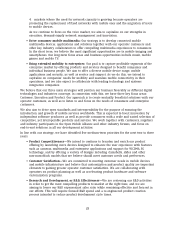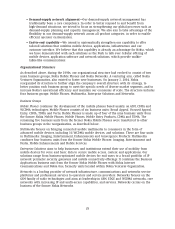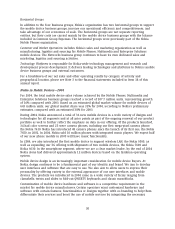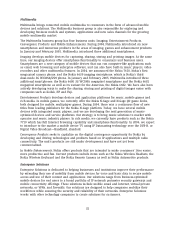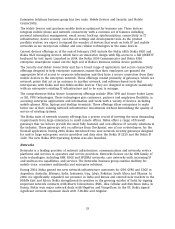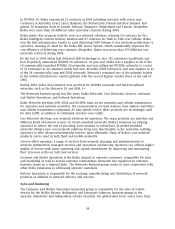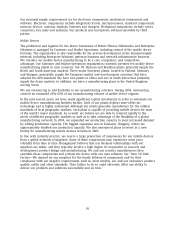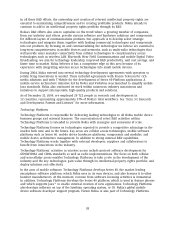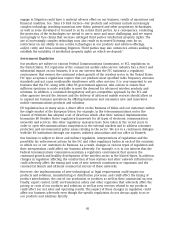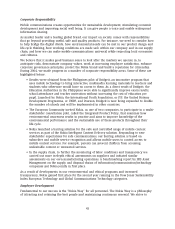Nokia 2004 Annual Report Download - page 39
Download and view the complete annual report
Please find page 39 of the 2004 Nokia annual report below. You can navigate through the pages in the report by either clicking on the pages listed below, or by using the keyword search tool below to find specific information within the annual report.In all these R&D efforts, the ownership and creation of relevant intellectual property rights are
essential to maintaining competitiveness and to creating profitable products. Nokia intends to
continue to add to its intellectual property rights portfolio through its R&D.
Nokia’s R&D efforts also aim to capitalize on the trend where a growing number of companies,
from our industry and others, provide various software and hardware solutions and components
for different layers of communications products. Our approach is to develop select strategic
technologies and integrate them, together with leading commercial technologies and components,
into our products. By focusing on and commercializing the technologies we believe are essential to
long-term competitiveness in mobile devices and networks, such as multi-radio technologies that
will provide users seamless connectivity from cellular technologies to complementary access
technologies such as wireless LAN, Bluetooth, Near Field Communications and mobile Digital Video
Broadcasting, we aim for technology leadership, improved R&D productivity, unit cost savings, and
faster time to market. Nokia believes it has a competitive edge in this area because of its
experience with integrating wireless access technologies into small mobile devices.
During 2004, Nokia entered into several technology development agreements with operators to
jointly bring innovations to market. These included agreements with France Telecom for rich
media solutions and with T-Mobile for the development of Series 60 Platform applications. A
mobile service architecture initiative led by Nokia and Vodafone was launched to simplify mobile
Java standards. Nokia also continued its work within numerous industry associations and
initiatives to support interoperable, high-quality products and solutions.
As of December 31, 2004, we employed 20 722 people in research and development in
12 countries, representing approximately 37% of Nokia’s total workforce. See ‘‘Item. 5.C Research
and Development, Patents and Licenses’’ for more information.
Technology Platforms
Technology Platforms is responsible for delivering leading technologies to all Nokia mobile device
business groups and external licensees. The concentration of select R&D activities within
Technology Platforms is intended to provide Nokia with synergies and economies of scale.
Technology Platforms focuses on technologies expected to provide a competitive advantage in the
market both now and in the future. Key areas are cellular access technologies, mobile software
platforms such as Series 60, mobile device hardware platforms, components and modules, and
mobile device architecture management. In addition to strong internal R&D capabilities,
Technology Platforms works together with external developers, suppliers and collaborators to
benefit from innovations in the industry.
Technology Platforms’ activities in wireless access include protocol software development for
GSM/WCDMA and CDMA standards as well as radio implementations. The focus on both cellular
and non-cellular access enables Technology Platforms to take a role in the development of the
industry and the key technologies, gain value through its intellectual property rights portfolio, and
deploy solutions cost effectively.
In the area of mobile software, Technology Platforms develops Series 60, the market leading
smartphone software platform, which Nokia uses in its own devices, and also licenses it to other
handset manufacturers. At the moment, revenue from software licensing activities is immaterial.
In addition, Technology Platforms develops the Series 40 platform, which is used in feature phones
and which supports Java to enable external creation of new applications. Technology Platforms
also develops software on top of the Symbian operating system, or OS. Nokia’s global mobile
device software developer support program, Forum Nokia, is also part of Technology Platforms.
38


